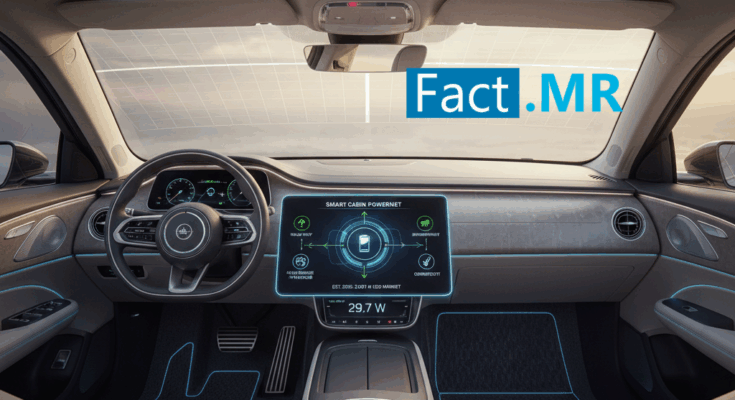The global In-Cabin Energy Harvesting Systems Market is entering a high-growth phase, projected to reach USD 2,987 million by 2035, expanding from USD 1,297 million in 2025 at a CAGR of 8.7%, according to recent industry analysis. As vehicles evolve toward connected, intelligent, and sustainable architectures, energy harvesting technologies are becoming the foundation of next-generation smart cabin ecosystems.
The technology—once limited to research prototypes—is now a commercial priority among automotive OEMs and Tier-1 suppliers striving to create battery-free, self-sustaining cabin environments. The ability to convert vibration, heat, or light into electricity allows for low-maintenance, wire-free sensor networks that improve comfort, safety, and energy efficiency.
Automakers Embrace Self-Powered Cabin Intelligence
Driven by the rise of digital interiors and the consumer demand for intuitive, hygienic, and connected mobility, automakers are aggressively integrating in-cabin energy harvesting systems. The most significant progress is seen in piezoelectric and thermoelectric technologies, which together dominate over half of the total market share.
By 2025, the piezoelectric segment alone accounts for 36.5% of the global market, powering modules such as seat occupancy sensors, lighting controls, and HMI touch interfaces. These systems convert mechanical vibrations from vehicle motion into usable energy, eliminating the need for conventional wiring or battery replacements.
The demand is further amplified by vehicle wellness applications—from real-time air quality monitoring to touchless interaction modules—where self-powered sensors enhance passenger comfort and reduce electrical load. With rising EV adoption, OEMs are prioritizing autonomous cabin power solutions that support extended range and improved efficiency.
In-Cabin Energy Harvesting Systems Market Regional Dynamics: Asia Leads, North America Innovates
Regional growth patterns reveal a dynamic global landscape.
- North America—driven by the U.S.—continues to lead in innovation, supported by strong EV sales and consumer preference for connected, sustainable interiors. Automakers are integrating thermoelectric and piezoelectric modules in response to energy efficiency regulations and the rise of digital retailing.
- Europe, particularly Germany, France, and the U.K., maintains its momentum through stringent sustainability targets and eco-design compliance. European OEMs are leveraging energy harvesting technologies to reduce cabin power consumption and enhance vehicle recyclability.
- Asia Pacific is the fastest-growing region, led by India (11.3% CAGR) and China, where rapid EV penetration, rising disposable income, and local manufacturing initiatives are accelerating adoption. Indian suppliers are producing cost-efficient, compact harvesting modules suited for both mass-market and premium models.
- The Middle East and Latin America are emerging as future opportunities, driven by premium vehicle demand and growing awareness of digital in-cabin systems.
In-Cabin Energy Harvesting Systems Market EV Revolution Sparks Technology Acceleration
Electric vehicles (EVs) are transforming the in-cabin energy harvesting landscape. OEMs are increasingly utilizing thermoelectric, photovoltaic, and piezoelectric systems to reduce auxiliary battery loads. These technologies help power ambient lighting, climate control sensors, and infotainment triggers, optimizing overall vehicle energy consumption.
The compatibility of energy harvesting with EV architectures enables designers to embed thin, flexible power-generating layers into dashboards, sunroofs, and door panels. This not only enhances sustainability branding but also aligns with consumer expectations for minimalist, future-ready cabin designs.
Technology Spotlight: Thermoelectric Systems Take Center Stage
Among the most promising advancements, thermoelectric systems stand out as the preferred power source for self-sustaining cabin modules. By converting temperature differences into electric power, these systems deliver silent operation, high reliability, and maintenance-free performance.
Thermoelectric devices are being integrated into HVAC vents, dashboards, and sun-exposed surfaces, enabling continuous energy generation even in extreme weather. Global OEMs are actively investing in next-generation thermoelectric materials to improve conversion efficiency and reduce dependence on chemical batteries.
This aligns with the broader sustainability narrative—manufacturers are leveraging biodegradable materials and low-voltage safety components to comply with global carbon-neutrality goals.
In-Cabin Energy Harvesting Systems Market Competitive Landscape and Strategic Investments
Key players shaping the global in-cabin energy harvesting market include EnOcean GmbH, STMicroelectronics, Texas Instruments, Cymbet Corporation, and Analog Devices Inc. These companies are investing heavily in micro-energy modules, energy management ICs, and hybrid harvesting technologies.
In June 2025, Analog Devices Inc. launched ADVentures, an $80 million corporate venture capital fund targeting early-stage startups focused on advanced sensing, secure connectivity, and energy innovation. This strategic move underscores the company’s commitment to accelerating R&D in micro-energy sources and ultra-low-power management modules for automotive interiors.
The competitive ecosystem is further fueled by partnerships between automotive OEMs and component suppliers, focusing on platform-level integration of harvesting technologies. The objective: build modular, retrofit-friendly cabin architectures capable of supporting evolving vehicle software and user experience trends.
In-Cabin Energy Harvesting Systems Market Opportunities and Challenges Ahead
While opportunities abound, manufacturers must overcome challenges including high material costs, integration complexity, and variable energy yield under different cabin conditions. Piezoelectric ceramics and flexible thermoelectric materials remain expensive, which can restrict adoption in entry-level segments.
Moreover, ensuring consistent power output amid fluctuating temperature, light, and motion levels remains an engineering hurdle. However, the market’s R&D momentum—supported by AI-based power management and material innovations—suggests steady improvement in performance and cost efficiency.
T In-Cabin Energy Harvesting Systems Market he Road Ahead: A Call to Industry Leaders
As vehicle interiors evolve into digital, sensor-rich environments, in-cabin energy harvesting systems are transitioning from futuristic concept to market necessity. By aligning with global sustainability goals and reducing dependence on traditional batteries, this technology promises a new era of clean, intelligent, and self-sustaining cabin design.
For automotive leaders, suppliers, and innovators, now is the time to invest in R&D collaboration, localized production, and scalable integration frameworks. The market’s expansion toward nearly USD 3 billion by 2035 signals one clear direction—
Browse Full Report : https://www.factmr.com/report/in-cabin-energy-harvesting-systems-market



